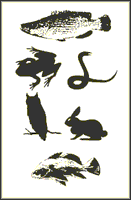Nebraska Cooperative Fish and Wildlife Research Unit

Nebraska Cooperative Fish and Wildlife Research Unit: Staff Publications
Date of this Version
4-17-2022
Citation
North American Journal of Fisheries Management 42:926–938, 2022. DOI: 10.1002/nafm.10779
Abstract
Freshwater fish populations often exist in systems characterized by novel ecological processes resulting from human alteration. Salmonid populations embedded within coldwater sections of warmwater rivers are spatially constrained by habitat availability. Tailwater fish contend with fluctuating river discharges and density-dependent processes associated with fish stocking and exploitation. Salmonid populations sustained through stocking versus natural reproduction may respond differently to changes in hydrologic patterns (e.g., hydropeaking) as well as declines in fish abundance. We assessed differences between stocked (Rainbow Trout Oncorhynchus mykiss) and naturalized (Brown Trout Salmo trutta) trout populations in Greers Ferry tailwater, Arkansas, regarding (1) spatial and temporal patterns of mean length, electrofishing catch rates, and relative condition following reduced number of stocked Rainbow Trout and (2) evidence that hydrologic characteristics and fish stocking intensity influenced relative condition. A 56% reduction in Rainbow Trout stocking did not result in systemwide change in mean length or relative abundance for Rainbow Trout or Brown Trout over the 16-year study period. Hydrologic variability, where river discharge spanned both reduced and elevated levels, positively influenced condition of both Rainbow Trout and Brown Trout. Assessment of survival of stocked Rainbow Trout may aid in further refining the timing and amount of stocking needed to sustain the population at a desired abundance. Further, assessing the influence of stocking fewer but perhaps larger (in terms of mean length) fish to meet management goals may be warranted. The persistent differences in relative abundance among river sections can inform management actions directed at Brown Trout, including harvest regulations. Such regulations may aid in reaching desired management goals, including abundance and mean length targets not observed after reduced stocking.
Included in
Aquaculture and Fisheries Commons, Environmental Indicators and Impact Assessment Commons, Environmental Monitoring Commons, Natural Resource Economics Commons, Natural Resources and Conservation Commons, Water Resource Management Commons


Comments
Public domain in the USA.